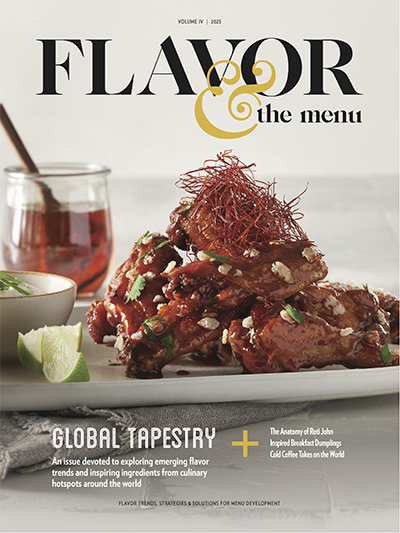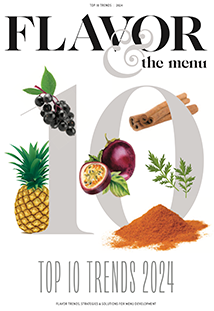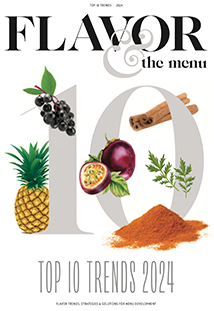
As an industry and a culture, we are entering a new frontier in food. The focus on plant-forward innovation, coupled with the rise in flexitarianism, is leading to culinary- and lab-based experimentation. The result of this experimentation is two-fold. First, there is now an exponentially broader variety of plant-based alternatives from meat analogs to dairy substitutes. Second, operators are finding ways to turn animal-based ingredients into craveable complements to a plant-forward experience.
What makes this moment in plant-forward innovation unique is that much of the experimentation is focused on creating options for those not committed to vegan and vegetarian lifestyles. Though more consumers are practicing both, these groups still make up a small share of the population. So restaurants are considering plant-forward innovation from a meat-focused consumer perspective. As a result, the finished products are exciting and appealing to a broader audience, and can be enjoyed for what they are, which is often truly delicious meals or complements.
Here are five menu categories transforming as a result of plant-forward innovation:
1. Burgers
Perhaps no category has been as significantly impacted by plant-forward innovation as the burger category, thanks to the introduction of meat analogs such as Impossible and Beyond Burgers. This may not be the case for long as these manufacturers, and new players, experiment with options from chicken to seafood replicas, but for now, consumers are most likely to find the most innovative options within the burger category. Beyond the science-based analogs, operators are creating housemade plant-based burger options that are a far cry from the dry options of the past. Others are working produce and legumes into meat-based patties to increase the healthfulness and decrease calories and fats. Look for Impossible burgers, Beyond Burgers, beef/mushroom blends, beef/mushroom/bean blends, quinoa-based, black bean-based, and beet-based options.
2. Bar Snacks/ Shareables
In the past, the only ubiquitous plant-based bar snack was a bowl of nuts, and shareable items typically focused on meat protein options like chicken wings. Both categories—bar snacks and shareables—are now liberally incorporating innovative plant-forward options using impactful preparations, visually engaging presentations and fantastic innovation. New options for either category include dips and spreads such as muhammara and dukkah, vegetable finger foods from battered and fried to pickled, dishes based on sprouted rices and grains, popped grains beyond corn including quinoa, farro and sorghum, and preparations more commonly reserved for meats such as beer-braising and blackened.
3. Beverages
From a focus on functional ingredients to drinks sourced from global cuisines, the beverage category is one of the most exciting on the menu today. Experimentation and produce-forward beverages are driving innovation in juices, smoothies, sodas and cocktails (alcoholic and nonalcoholic). Interesting beverage options for innovation include housemade produce-based simple syrups such as rhubarb and coconut, fresh juices from carrot to kale, new nondairy “milks,” including oat and cashew (particularly good for frothing), natural colors from produce including beets and turmeric, and seasonal produce, naturally.
4. Global Cuisine
Much of the inspiration for plant-forward innovation comes from world cuisines. Most other cultures in the world consume less animal-proteins or products than do Americans, and many cultures have historically focused on plant-forward dishes for a variety of reasons from religious to economic. Thanks to the broader access to and understanding of many far lesser known (until now) culinary heritages, chefs can draw from and be guided by these ancient heritages. While some cuisines such as Mediterranean have been slowly shifting how American consumers view plant-forward dining for some time, up-and-coming cuisines lending their unique voices to the plant-forward conversation include Ethiopian, Burmese, Indian, and Levantine.
5. Desserts
Always a challenging category for operators, desserts are enjoying a resurgence in interest largely driven by the increased variety of desserts with a healthier halo, thanks to produce-forward innovation. Whether positioned as indulgent with a healthful spin, primarily healthy with an indulgent touch, or vegan, these new desserts are reintroducing consumers to the idea that desserts shouldn’t be left solely to special occasions, but can be enjoyed frequently as part of holistically healthy eating. Plant-forward innovations in the dessert category include: creative preparations that change the texture such as sous vide and quicklime soaks; produce using multiple preparations in one dish for complex flavor and texture; nondairy alternatives including nut- or grain-based milks and cheeses; aquafaba; preparing and pairing vegetables to highlight sweet flavors for unexpected experiences, and vegan ice creams.







